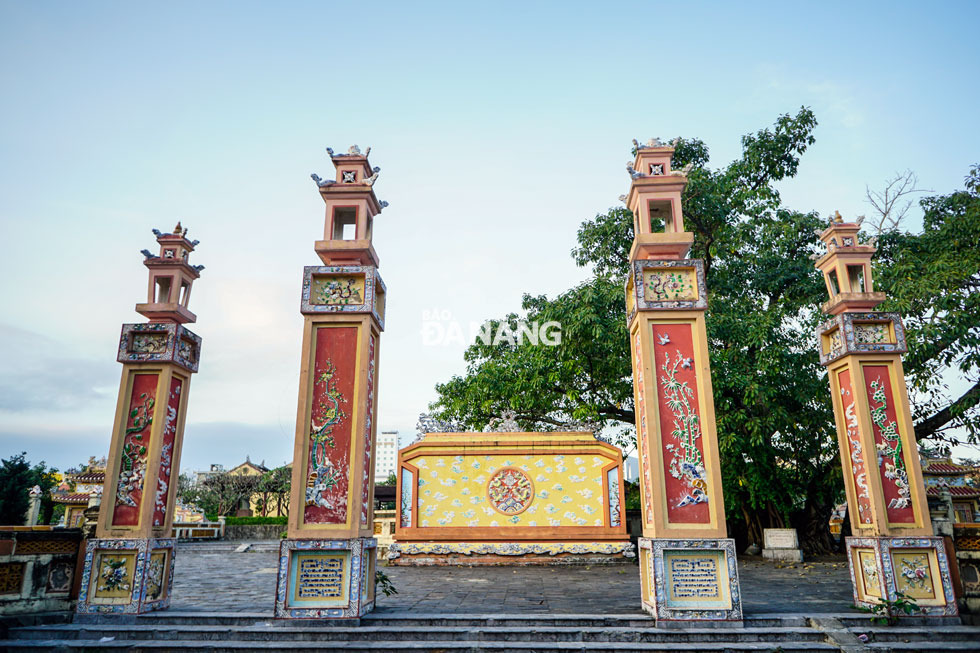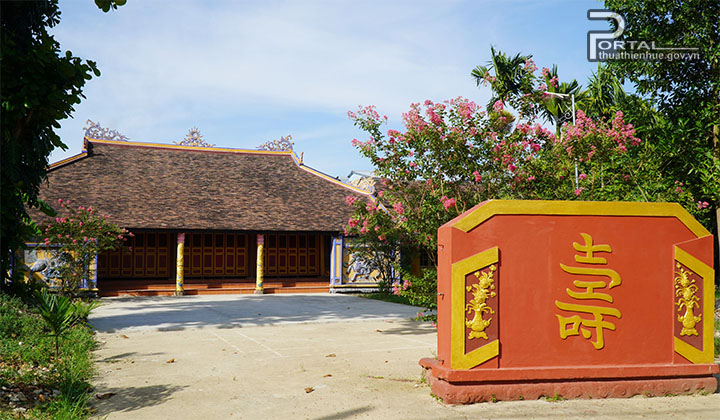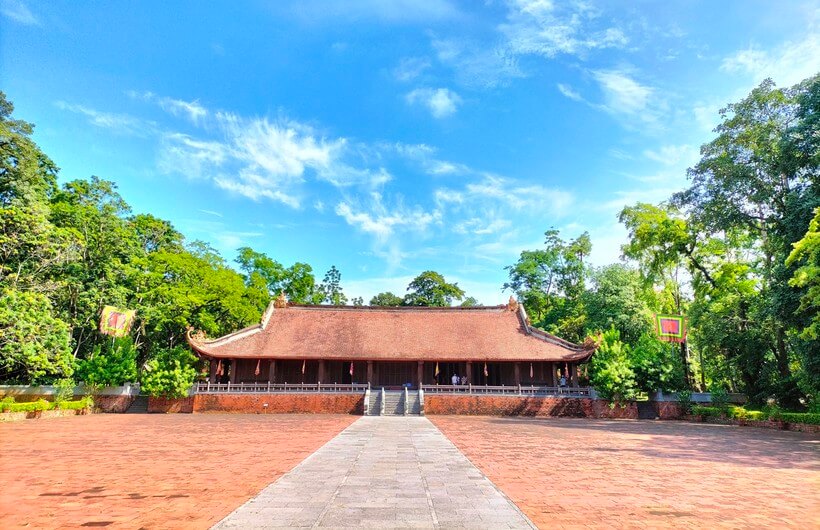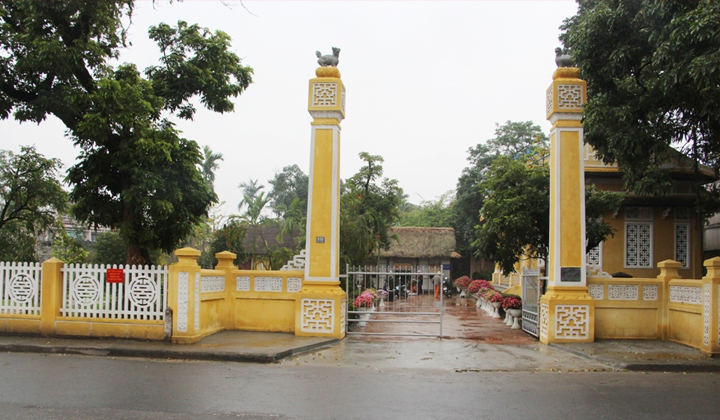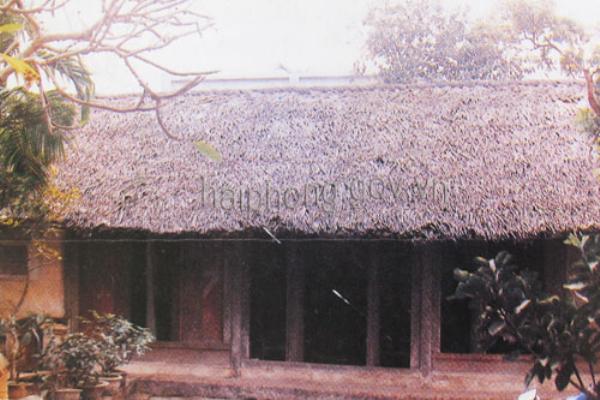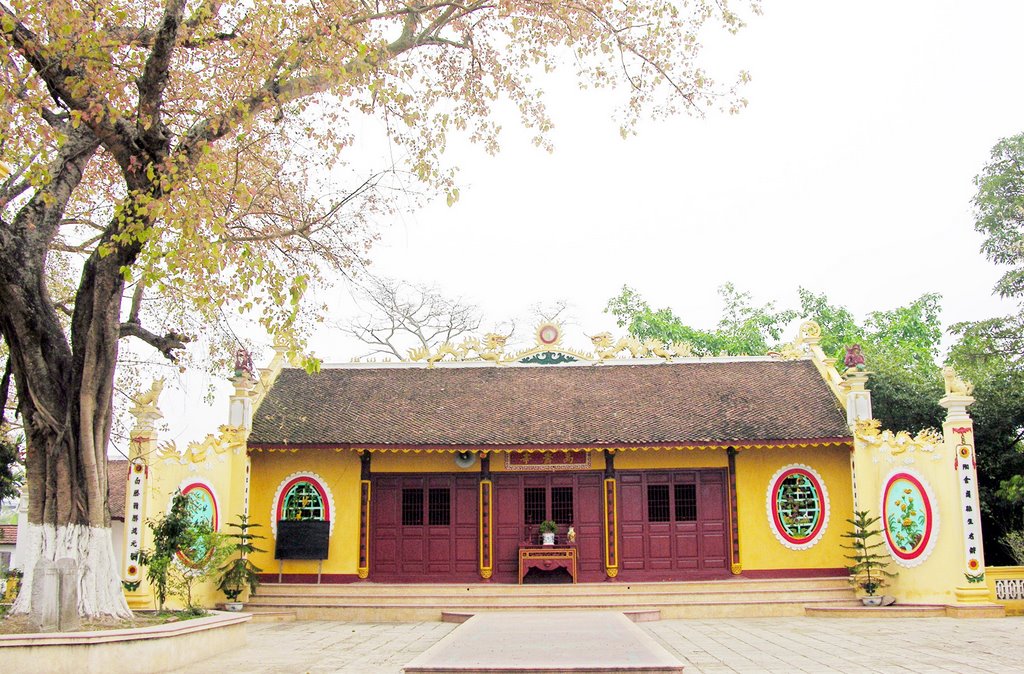Relic point Vietnam
Việt NamTien Hien Church of An Hai and Thoai Ngoc Hau
Tien Hien Church of An Hai and Thoai Ngoc Hau (An Hai Tay Ward, Son Tra District) is known not only the church of a large village, with a long history in Da Nang, but this is also In the sacrifice of a famous historical figure of the hometown of An Hai. It is Thoai Ngoc Hau - Nguyen Van Thoai, a famous general in the South in the North, revered by the people of Chau Doc, An Giang as a god. He is from North My An village, Dien Phuoc district, Quang Nam town, now North My An ward, Son Tra district, Da Nang city. The real name is Nguyen Van Thuy, the taboo that changes is a voice. During his childhood, Nguyen Van Thoai and his family migrated to the South of the Lord Nguyen Phuc Khoat (1738-1765), living in Thoi Binh village, on the long islet, now in Vung Liem district, Vinh Long province. At the age of 16 (1777), joining Nguyen Anh Sang Bangkok (Thailand), returning home to lead the army to fight Tay Son, to be Kham Sai Cai Co, and then Kham Sai Trinh Cai Co, was promoted to the Marquis (so he later later. Often called Thoai Ngoc Hau). In 1789, as Deputy Business Administration was promoted to the Thuong Binh Tay Tay General. In 1799, he was sent to work in Vien Vien (Laos). After Nguyen Anh ascended to the throne (1802), he was promoted to the army to look after the Northern citadel, then led the Lang Son. Being assigned to work as a town, then he was appointed as the army to protect the Cao Mien. In 1818, it was supplemented as Vinh Thanh town (now Long Xuyen - Can Tho). Here, he and the local army designed and operated the people of Dong Xuyen canal (in Long Xuyen). This channel after completion is named Thoai Ha. In the first year of Minh Mang (1820), he controlled 80,000 workers working for 5 consecutive years (1820-1824) to dig the canal connecting Chau Doc with Ha Tien, leading the water to the west. This is a big project designed and commanded by him, bringing great results in the exploration of Hau Giang. Nguyen Van Thoai also has a solemn grave in An Hai, Chau Doc, turning the deserted land in the border into a rich and crowded population. Nguyen Van Thoai is a martial arts talent, an excellent diplomatic political activist, (twice being sent as a Cao Mien protection), when he went to the blanket, when he was sent to solve the border problem North (Lang Son), when returning to the southwest border. He is also a business, an economic activist with a strategic vision and a good organization. He died on the 6th of June of the Year of the Ox at the Chau Doc office, the body was buried at the foot of Thoai Son mountain. Remembering his merits and career, the people formed the mausoleum. Thoai Ngoc Hau Lang was recognized by the Ministry of Culture and Information as a national cultural and historical monument. In An Hai ward, Son Tra district, Da Nang city, Thoai Ngoc Hau temple was built very spacious. Tien Hien Church of An Hai and Thoai Ngoc Hau (An Hai Tay Ward, Son Tra District) is known not only the church of a large village, with a long history in Da Nang, but this is also In the sacrifice of a famous historical figure of the hometown of An Hai. It is Thoai Ngoc Hau - Nguyen Van Thoai, a famous general in the South in the North, revered by the people of Chau Doc, An Giang as a god. Tien Hien Church of An Hai and Thoai Ngoc Hau village was ranked national monuments in 2007. The industrial beer of Thoai Ngoc Hau 2m high, 1.2m wide with white stone, face to the west. Thoai Ngoc Hau's bust statue is 1.2 meters high, weighing nearly 1 ton, turning to the east, straight with the right stele. The main hall and post -impregnation of the church is about 160m2, designed and embellished in the ancient communal house. Ngoc Hau altar is located in the main hall center with statues and tablets. Source of Danang City Electronic Portal
Da Nang 2384 view
Nguyen Tri Phuong church and mausoleum
Nguyen Tri Phuong's church and mausoleum are located in Chi Long Village, Phong Chuong commune, Phong Dien district, Thua Thien Hue province. From Hue city center, follow National Highway 1A (30km North to Phong Thu commune, Phong Dien district) turn right along Provincial Road 6 about 15km to reach the monument. Nguyen Tri Phuong, real name is Nguyen Van Chuong, alias Ham Trinh, alias Duong Xuyen, born on July 21, Canh Than year (1800), hometown in Duong Long village (Chi Long), Chanh Loc canton, Phong Dien district, province Thua Thien (now Phong Chuong, Phong Dien). He served as a mandarin under the reigns of Kings Minh Mang, Thieu Tri, and Tu Duc, held many important positions in the royal court, was a Minister of the Nguyen Dynasty, and had many contributions to the expansion of Cochinchina and fighting the invading French colonialists. . He was injured during the French army's attack on Hanoi Citadel on November 19, 1873, then went on hunger strike and died on December 20, 1873 (ie the 11th day of the lunar calendar), at the age of 73. King Tu Duc had his body brought back for burial in his hometown and provided materials to build a church with his younger brother Nguyen Duy and son Nguyen Lam, both of whom had meritorious service in fighting the French colonialists. The church relics and Nguyen Tri Phuong's mausoleum were recognized as national relics in Decision No. 575-Decision/Culture and Information dated July 14, 1990 of the Ministry of Culture and Information (now the Ministry of Culture and Information). Culture, Sports and Tourism). Source: Thua Thien Hue Electronic Information Portal.
Hue 3142 view
The Lai Thuong Communal House and Temple opened
The Lai Thuong communal house and temple are located on Bach Dang street, Phu Hiep ward (now Gia Hoi ward), Hue city, Thua Thien Hue province. The Lai Thuong Communal House - Temple was built on the land of The Lai village - an ancient village in Thuan Hoa, born over 500 years ago. Later, The Lai village split into two villages, The Lai Thuong and The Lai Ha. . Currently, The Lai Thuong village is located in Phu Hiep ward (now Gia Hoi ward), Hue city. Dinh The Lai Thuong faces West-South. In front is Dong Ba canal. The campus is 1,200 square meters wide, surrounded by a castle. The Lai Thuong Communal House is structured as follows: Tam Quan Gate with 4 tall, square pillars, embossed with parallel sentences in Chinese characters, 5m away from the pillars is a pair of cranes standing on the backs of turtles flanking a 1.8m high lantern, followed by is the courtyard. The communal house is built in the style of a three-compartment, two-winged house, 12m long, 9m wide, with 26 main columns and 4 porch columns. The main decorative theme is the four sacred animals, some flowers and leaves symbolizing the four seasons and the Bat Buu systems, all framed in boxes. The interior is divided into 2 parts: Harem and Front Hall (or Bai Duong). Temple of God The Lai Thuong has a three-entrance gate built in the style of an arched door. The Temple's architecture is in the style of a three-compartment, two-winged house, with 36 wooden columns, the main decorative themes are four sacred animals, tigers, and four-season flowers. The Lai Thuong Communal House and Temple is a cluster of relics containing many outstanding historical, architectural, artistic and socio-cultural values. This cluster of relics has been ranked as a national relic according to Decision No. 05/1999 Decision-Ministry of Culture and Information dated January 12, 1999 of the Ministry of Culture and Information (now the Ministry of Culture, Sports and Tourism). Source: Thua Thien Hue Electronic Information Portal.
Hue 3159 view
Lam Kinh historical relic site
Nestled in the heart of a land of outstanding people, Lam Kinh Historical Relic Area (Tho Xuan district, Thanh Hoa) has typical royal architecture and bold historical and cultural imprints, a testament to a period of time. brilliant development of the country. Located in Xuan Lam commune, Lam Son town, Tho Xuan district, 50km west of Thanh Hoa city, Lam Kinh historical relic site not only retains intact the works of the Later Le dynasty, but also preserves many precious antiques of a time considered the most prosperous in Vietnamese history. Lam Kinh historical relic site carries many sacred cultural values not only for the people of Thanh Hoa but for the entire nation. This is a unique artistic architectural work, bearing the mark of royal culture along with all the inscriptions and tombs, demonstrating each step of the brilliant development of the country's architecture. The temples and mausoleums are arranged according to Confucianism and feng shui perspectives, with harmony between hills, streams, and trees, creating a beautiful environment, balanced between natural landscape and architecture. . The ancient Lam Kinh citadel was built according to the terrain "located on the mountain facing the water", a gold standard in feng shui of Asian people. The north of the citadel is based on Dau mountain, the south overlooks the Chu river, has Chua mountain as a screen, the east is Phu Lam forest, and the west is protected by Huong mountain and Ham Rong mountain. The royal citadel, palace and temple of Lam Kinh citadel are still kept intact to this day, with a chessboard layout including the noon gate area, dragon yard, main hall, temple... The road leading to the royal citadel has a dug river called Ngoc River, this flow originates from Tay Ho, loops around the front of the citadel and Lam Kinh palace. Bach Bridge (Tien Loan Kieu Bridge) over Ngoc River is the main path leading tourists to visit Lam Kinh ancient citadel. The bridge has a bow shape, made in a unique architectural style called Thuong Gia Ha Kieu, meaning above the house, below the bridge. Cross the bridge about 50m to an ancient well, the well water is clear and full all year round, the North bank is paved with stone steps up and down, providing water for Lam Kinh palace. In the past, the well was filled with beautiful and fragrant lotus flowers, while keeping the water cool during the summer days Right behind the main hall are 9 Thai temples decorated solemnly and sacredly with a bow shape embracing the main hall. This is the place to worship the kings and queen mothers of the Later Le Dynasty, mainly the Early Le Dynasty, with a majestic and sacred scene all year round filled with incense smoke. In 1962, Lam Kinh Historical Relic Area was recognized as a National Historical Site, and in 1994, the Government approved a restoration project. In 2012, this place continued to be recognized as a special National Monument. SOURCE: VIETNAM NATIONAL TOURISM BUREAU
Thanh Hoa 557 view
Ma Pi Leng
Ma Pi Leng (Ha Giang) is famous as one of the "four great passes" in the northern mountains of our country, along with O Quy Ho Pass (connecting Lao Cai and Lai Chau), Pha Din Pass (connecting Lao Cai and Lai Chau). Son La and Dien Bien) and Khau Pha pass (Yen Bai). Ma Pi Leng Pass, also known as Ma Pi Leng, Ma Pi Leng (meaning "horse's nose bridge") is known as the king of passes in the Northwest mountains, a dangerous pass about 20km long, in Pa Vi and Pai Lung communes, Meo Vac district and Ta Lung commune, Dong Van district. Ma Pi Leng peak is located at an altitude of 1,200m in the Dong Van Karst Plateau on the road named Hanh Phuc connecting Ha Giang city with Dong Van and Meo Vac districts. From the top of Ma Pi Leng, visitors can enjoy a panoramic view of the Dong Van Stone Plateau. Majestic mountain scenery with steep cliffs on one side and the deep abyss of the Nho Que River with emerald green water on the other. Tourists can come to Ma Pi Leng from January to March because this is the time of flower seasons such as plum, peach, mustard, April attracts the Khau Vai love market, September attracts the Khau Vai love market. The ripe rice season on Hoang Su Phi or November and December is the season of buckwheat flowers. SOURCE: VIETNAM NATIONAL TOURISM BUREAU
Tuyen Quang 3020 view
The mausoleum, church, and cemetery are named after Phan Boi Chau
The mausoleum, church, and cemetery named after Phan Boi Chau are at No. 53, Phan Boi Chau Street, Truong An Ward, Hue City, Thua Thien Hue Province. Phan Boi Chau - famous Vietnamese patriot, thinker, poet, and writer in the early twentieth century. After many years of traveling abroad to find a way to save the country, in 1925 Phan Boi Chau was arrested in Shanghai (China) and secretly brought to Hanoi by the French colonialists. Faced with the nationwide people's struggle movement demanding amnesty for him, the French colonialists had to put him under house arrest in Hue for 15 years (1925-1940). Mr. Phan's house on Ben Ngu slope: Mr. Phan's house was built between 1926-1927. The house was designed by him himself and built by Mr. Vo Liem Son - a teacher at Quoc Hoc School. The house has a horizontal square shape, three rooms with thatched roofs, symbolizing the three periods (North, Central, South), with relatively high and airy mud walls. The middle of the house is square, used as a place for speeches. There are separate rooms surrounding the room. Phan Boi Chau's mausoleum: The mausoleum was located by Mr. Phan Boi Chau in 1934, located right in front of the house and in the middle of the garden. After Mr. Phan passed away (October 29, 1940) with money from compatriots throughout the country, Mr. Huynh Thuc Khang built the tomb and church. The tomb is 7m long, 5m wide, has 5 steps 0.8m high, about 1m from the screen at the head of the tomb is a stele 1.8m high, 0.8m wide, on the stele there is the poem "Tu Minh" in Chinese characters were written by Mr. Phan in 1934. Mr. Phan Boi Chau Church: Built by Mr. Huynh Thuc Khang in 1941 along with the mausoleum area. The church was built on the right side of the house, formerly a 3-compartment house with brick walls and a tiled roof. The house is 7.5m long and 6m wide. Tu Duong: Tu Duong was built from April 1955 to 1956, designed by Mr. Ton That Sa, doctor Than Trong Phuoc was the Head of Construction. From the street is a large, massive tiled house, about 8m high, with a yin-yang tiled roof, facing the tomb of Phan Boi Chau. In front of Tu Duong, there is a sign with the words "From the path of predecessor martyrs and Mr. Phan Boi Chau". Currently, the Tu Duong throne has been partly used by the Thua Thien Hue Museum of History and Revolution to organize exhibits about Mr. Phan's life and career. Along with the main relics, in the garden area of Mr. Phan Boi Chau's house, there are also a number of other relics: Tomb of Tang Bat Ho, tomb of Mr. and Mrs. Phan Nghi De (son and daughter-in-law of Mr. Phan), stele house worshiping Au Trieu Le Thi Dan, wells... The statue of Mr. Phan is located on the right side of the garden. The statue was made by sculptor Le Thanh Nhon in 1973 with the participation of the Committee of Liberated Teachers and Intellectuals (under the Hue City Party Committee), the College of Fine Arts, Mr. Phan's family and other representatives. representatives, student officials and Hue students. The statue of Mr. Phan is the largest bronze statue in Vietnam, 3 meters high and weighing 4 tons of bronze. The statue is placed on a 2m high rectangular pedestal made of crushed stone. Cemetery named after Phan Boi Chau: The cemetery named after Mr. Phan Boi Chau is a 4,000m2 garden, near the Nam Giao herd, bought by Mr. Phan at the same time as the land to build a house on Ben Ngu slope. In 1934, he built a stele clearly defining the standards for those buried here. In the current cemetery, there are the graves of comrades Nguyen Chi Dieu, female historian Dam Phuong, Hai Trieu, Le Tu Nhien, Thanh Hai... The mausoleum, church, and cemetery named after Phan Boi Chau were recognized as national historical relics in Decision No. 575-Decision/Culture dated July 14, 1990 of the Ministry of Culture and Information (now the Ministry of Culture, Sports and Tourism) Source: Thua Thien Hue Electronic Information Portal.
Hue 3206 view
Ha Lung Communal House
Ha Lung communal house is located in Dang Hai ward, Hai An district, Hai Phong city. The communal house also has the literal name Nhan Tho communal house, built by Ha Lung villagers around the 18th century. The architecture of the communal house still has some wooden specimens because some of the remaining ends of the two sets of the communal house were carved. engraved with the artistic style of the 18th century Later Le period. It has undergone many major restorations; But there are 2 times of restoration recorded in the first sentence, Thuong Luong Dinh was during the reign of King Khai Dinh (1924) and 1995. Ha Lung Communal House is an architectural work in the style of Cong Diagon Dao Tau Corner, including: 5-compartment grand worship hall (including 3 main rooms and 2 sub-compartments), a 2-compartment water spinach house and a harem (3 rooms). The structure of the temple buildings is made in the style of "stacking of beams and gongs with variations", because the armpits are carved pillars on both sides with the themes of dragon, fish, water, turtle, carp crossing the Vu Mon. . The rafters of the two rooms of the morning glory and the roof are all carved with themes of the four sacred animals and four precious things. In general, the architectural wood system of Ha Lung communal house is quite massive and strong, the architectural components are carved in relief and with many rich, diverse and vivid themes. SOURCE: HAI PHONG CITY SOCIO-ECONOMIC INFORMATION DATABASE PORTAL
Hai Phong 2626 view
Cat Ba archipelago
Cat Ba archipelago is 60km from Hai Phong city center by sea, has an area nominated for World Heritage of 31,150ha with 388 islands. Administratively, Cat Ba archipelago belongs to Cat Hai district, Hai Phong city. This place has been recognized as a world biosphere reserve (in 2004), ranked by the Government as a Scenic Spot - Special National Monument (in 2013) and became the Ha Bay World Natural Heritage. Long - Cat Ba Islands (2023). Rolling limestone mountains interspersed with pine forests and bays; majestic caves; has diverse biological values and geological and geomorphological landscapes, creating the Cat Ba archipelago as a natural masterpiece. This is also the habitat of more than 3,000 species of animals and plants on land and in the sea, many of which are included in the Red Book of Vietnam and the world. In particular, the Cat Ba Langur is an endemic species, currently only distributed here. The archipelago consists of 388 large and small islands located on an area of about 345 km². The largest island of Cat Ba has an area of 153 km², is the third largest island in Vietnam after Phu Quoc and Cai Bau, with the highest peak of 331m. The remaining islands rarely reach heights of 100-250m, most are small islands with heights under 100m and very small islands are usually only 20-50m high. This is a tropical terrain area submerged by the advancing sea with a unique landscape similar to Ha Long Bay, with Phong Tung-style peaks, Phong Linh-style peaks, and funnels common. The islands are single or clustered peaks or towers, with steep cliffs floating above the clear blue sea. Many island names are based on the shapes of things such as Chili, Bell, Turtle Shell, La Vong, Dragon Tail, Leopard and Lion. Biochemical and mechanical corrosion of sea water due to waves and tides creates a concave coastal edge all around. Islands increase the strange and unique shape of the islands. On Cat Ba island there are valleys such as Trung Trang, Gia Luan, Tai Lai and Viet Hai. They have a height of 5-8m, a width of 100-600m, in some places up to 1km wide, stretching a few to tens of kilometers, filled with late fluvial-marine sediments. CAT BA ISLAND has many beautiful caves in three groups: ancient underground caves, foundation caves and sea frog caves. Ancient underground caves such as Hung Son cave, Hoa cave, Trung Trang cave, etc. are often over 10m high. Platform caves are common but are usually small in size and usually less than 10m high. Sea frog cave sometimes penetrates limestone blocks to form caves such as Xich cave and Dung cave. The coastal bottom terrain of CAT Ba ISLANDS includes pine forests, coral reefs, bay bottom plains and channels. Tung and ang are valleys or karst funnels submerged by the sea. Tung has 26 pieces with elongated shape (Bear Tung, Chang Tung). There are 33 angs with isometric shapes (ang Mat, ang Vem and ang Ke, etc.) SOURCE: Hai Phong City Electronic Information Portal
Hai Phong 3145 view
Secret agency of Hai Phong City Party Committee
The secret agency of the Hai Phong City Party Committee (period 1936 - 1939), located at Mr. Dang Thi Sau's house in Nam hamlet, Du Hang Kenh commune on the edge of Hai Phong urban area (now Than lane, residential cluster number 2, Du ward Hang Kenh, Le Chan district). Here, Party officials directly direct the struggle movement of workers and workers in factories and offices in rural areas. In September 1936, comrade Nguyen Van Linh (late General Secretary of the Central Committee of the Communist Party of Vietnam) returned from Con Dao and was assigned by the Party to organize and lead the revolutionary movement in Hai Phong. Comrade Nguyen Van Linh and comrade Nguyen Cong Hoa chose this place as the place to direct the revolutionary movement in Hai Phong during the period 1936 - 1939. In April 1937, the Hai Phong City Party Committee was established by comrade Nguyen Cong Hoa is Secretary. Thanks to the results of the work of organizing and developing Party bases and revolutionary mass bases, the struggle movement of workers and other labor circles in Hai Phong - Kien An flared up strongly again. When comrade Nguyen Cong Hoa moved to another job, comrade Nguyen Van Linh was appointed Secretary of the City Party Committee and continued to live and work at Mr. Dang Thi Sau's house. Here, many policies of the Hai Phong City Party Committee were quickly implemented to direct the revolutionary movement. In early 1939, comrade Nguyen Van Linh was assigned by the Central Government to strengthen the Saigon Party Committee, and comrade To Hieu was in charge of the revolutionary movement in Hai Phong and the mining area (Quang Ninh). The secret agency of the Hai Phong City Party Committee (period 1936 - 1939) at Mr. Dang Thi Sau's house is the only remaining revolutionary historical relic, relatively intact, of the glorious revolutionary journey of 1936 - 1939. . This relic was ranked by the State in 1998. SOURCE: Hai Phong City Electronic Information Portal
Hai Phong 2555 view
Nam Temple
Nam Temple is a religious structure erected by the people of Bac Son commune, An Duong district, Hai Phong city many centuries ago to worship historical figures who contributed to the country in the resistance war against invasion. of the Northern feudal forces, contributing to the establishment of the first autonomous Van Xuan state in the history of our nation's struggle to build and defend the country in the 6th century. According to the legend engraved on the stone tablet Four-sided square pillar dated Tu Duc 19th century on display at the Hai Phong Museum said: The historical figure worshiped at Nam Temple, Bac Son commune is a famous general, his name is Nguyen Hong, a local person. During the uprising against the domination of the Liang Dynasty (China) in the 6th century, Nguyen Hong joined Ly Bi's army, making many contributions to the destruction of the invading army. Luong, helped Ly Bi establish the Van Xuan state, opening a period of independence and autonomy for our nation. Due to his merits, when he passed away, Nguyen Hong was built by the people of his hometown to worship and worship him as the village's tutelary god, worshiped with incense and smoke for thousands of years. Nam Temple was originally called Nam Communal House. Legend has it that Nam Communal House was built right at the place where Nguyen Hong died, and the traces left to this day are that his grave is preserved right in the communal house's harem, above which is a majestic idol placed in an altar. During the years of resistance against the French, Nam communal house was destroyed, only the harem remained. Perhaps because the scale is so small, the villagers call this a temple. But with respect, gradually the local people spent a lot of effort and money to rebuild the temple to become more and more spacious and clean. Today, visiting the ruins of Nam Temple, Bac Son commune, we will see here the charm of traditional Vietnamese village communal house roofs and beautiful, splendid golden altar items, including a palanquin with bowls of tribute. unique in An Duong district. With many tangible and intangible values, in 1990, the State ranked the Nam Temple relic (Nam communal house), Bac Son commune, An Duong district, Hai Phong city as a Cultural Historical Monument. SOURCE: Hai Phong City Electronic Information Portal
Hai Phong 2723 view
